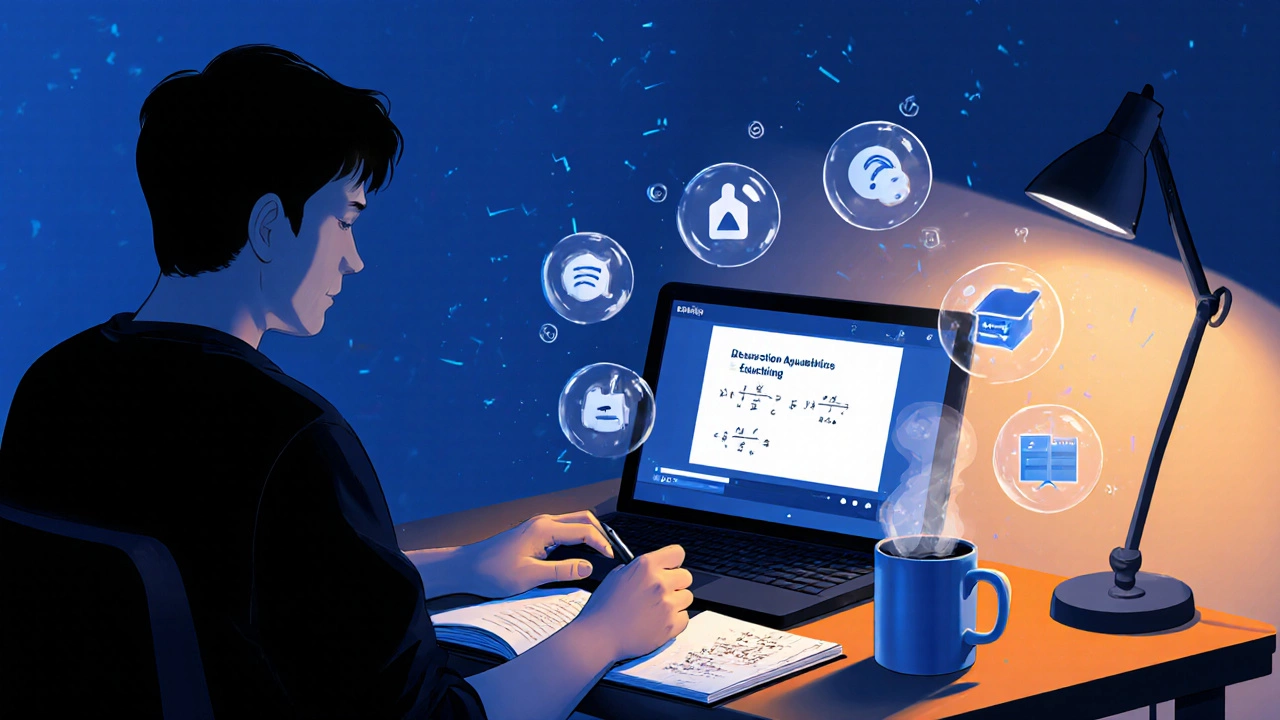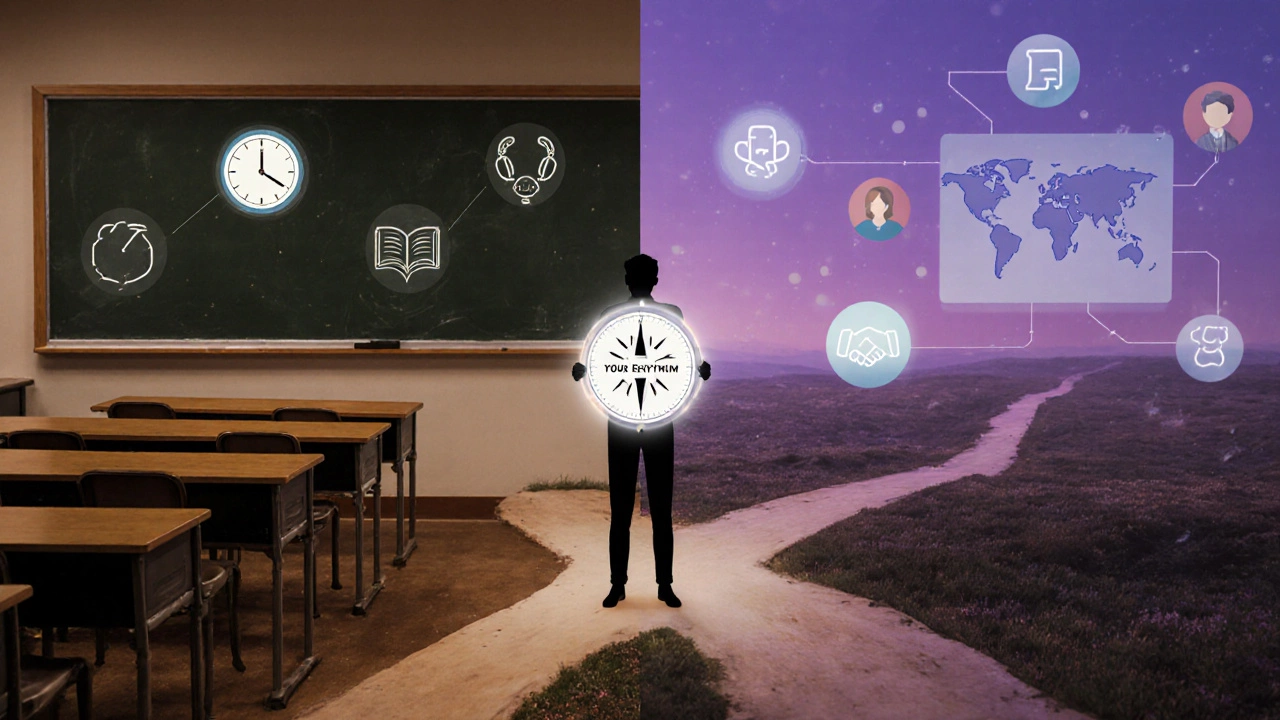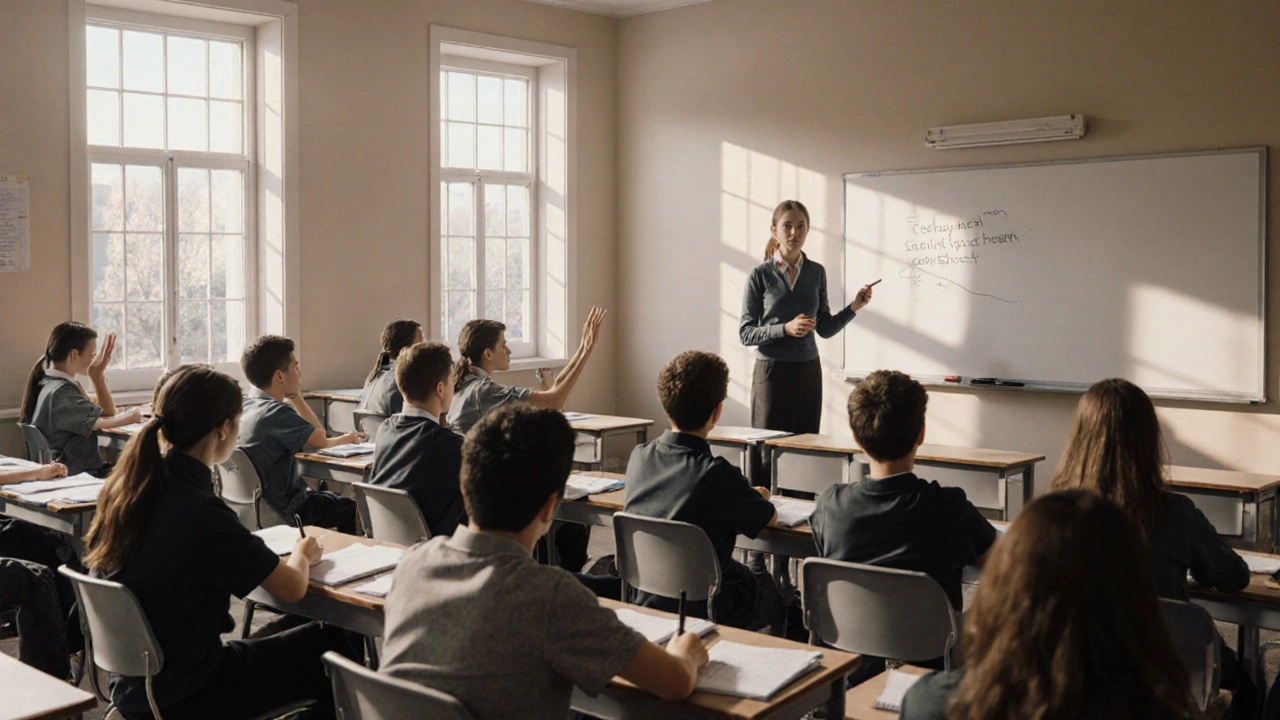Picture this: it’s 8 a.m. You’re sitting in a room with 30 other people, all staring at a whiteboard while a teacher talks at a steady pace. You missed the last point. You’re too shy to ask again. Now imagine you’re at home, pausing a video lecture, rewinding to understand a concept, then jumping into a discussion forum with students from five different countries. Which one feels more like learning?
Classroom learning is structured, but not always flexible
Classroom learning has been the default for over a century. It’s predictable. You show up at a set time, in a set place, with a set schedule. The teacher leads. You take notes. You raise your hand. You wait your turn. This structure works for some - especially younger students or those who need external accountability.
But here’s the catch: the pace is fixed. If you’re fast, you get bored. If you’re slow, you fall behind. And there’s no going back. Once the lesson moves on, you’re stuck unless you ask for extra help - which often means staying after school or scheduling a one-on-one, if the teacher has time.
Research from the U.S. Department of Education in 2023 found that in traditional classrooms, students only engage actively for about 30% of class time. The rest? Listening, waiting, or zoning out. That’s not because students aren’t motivated - it’s because the system doesn’t adapt to them.
eLearning puts control in your hands
eLearning flips the script. Instead of waiting for the teacher, you control the speed, the time, and often the path. You can watch a 10-minute video on quadratic equations at midnight, pause it to scribble notes, then replay the part you didn’t get. You can skip ahead if you already know it. You can rewatch until it clicks.
Platforms like Coursera, Khan Academy, and Moodle let you track your progress, take quizzes that adjust to your level, and get instant feedback. No more waiting days for a graded paper. You know right away where you stand.
And it’s not just about videos. Modern eLearning includes interactive simulations - like building a circuit in physics or practicing a foreign language conversation with AI. You don’t just learn about something. You do it.
Interaction looks different - but it’s still there
One big fear about eLearning? “You’re alone.” That’s not true. Sure, you’re not in a physical room. But you’re not isolated.
Online forums, live Q&A sessions, peer review groups, and breakout rooms in Zoom classes mean you’re still talking to others. In fact, some students find it easier to ask questions online. No one’s watching you stumble over your words. You can type it out, edit it, then post it. Quiet students often speak up more in digital spaces.
A 2024 study from the University of Auckland tracked 1,200 high school students switching from classroom to hybrid eLearning. Those who struggled to participate in class became 40% more active in online discussion boards. The anonymity helped. The flexibility encouraged.

Access isn’t equal - but it’s wider
Classroom learning requires you to be physically present. That means geography matters. You need to live near a school. You need transportation. You need to be able to get there on time, every day.
eLearning removes those barriers. A student in rural Nepal can take the same AP Biology course as a kid in Manhattan. A single parent working night shifts can study during lunch breaks. Someone with a chronic illness doesn’t have to miss a week because they’re too sick to leave the house.
But here’s the flip side: not everyone has reliable internet, a quiet space, or a device. In New Zealand, 92% of urban households have high-speed internet. In rural areas, that drops to 68%. That gap isn’t solved by technology alone. It’s solved by policy, investment, and community support.
Assessment changes - and so does the pressure
In a classroom, you get one shot: the final exam. You study for weeks, then sit down for three hours. Your grade depends on how you perform under pressure.
In eLearning, assessment is often spread out. Quizzes after each module. Projects submitted over weeks. Peer feedback. Self-assessments. This reduces the stress of one high-stakes test - but it demands more self-discipline.
You can’t cram the night before. You have to stay consistent. That’s harder for some. But for others, it’s liberating. You learn by doing, not by memorizing for a test you’ll forget in a week.
Cost and resources: what’s really being paid for?
Classroom learning looks expensive because of the building, the bus, the textbooks, the teacher’s salary. But those costs are hidden. You pay taxes. You pay fees. You don’t always see where the money goes.
eLearning platforms can be cheaper - or free. Many universities offer open online courses. Public libraries in Auckland give free access to LinkedIn Learning and Coursera. You don’t need to buy a new textbook every year. Everything’s digital.
But there’s a catch: the best eLearning tools cost money. Certificates. Personalized coaching. Advanced labs. If you want to go deep, you’ll pay. And if you can’t afford it? You’re locked out.
So while eLearning opens doors, it doesn’t automatically level the playing field. It just changes where the barriers are.

Which one works better for you?
There’s no winner. Only what fits your life.
If you’re a teenager who thrives on routine, needs face-to-face encouragement, and loves the energy of a group - classroom learning might be your best fit.
If you’re an adult juggling work and family, prefer to learn on your own schedule, and like to dig deep into topics that interest you - eLearning gives you power you never had.
And here’s the real shift: most people now use both. Hybrid models are the norm. You might attend a weekly in-person seminar, then do your readings and assignments online. You might watch lectures at home, then meet your study group at the library.
The future isn’t classroom vs. eLearning. It’s blending the best of both.
What you need to make eLearning work
If you’re trying eLearning for the first time, here’s what actually helps:
- Set a fixed time each day - even 30 minutes - to log in and learn.
- Create a dedicated space. Not your bed. Not the couch. A desk, a chair, a quiet corner.
- Turn off notifications. Seriously. Put your phone in another room.
- Join a study group - even if it’s just two people on Zoom.
- Track your progress. Use a simple checklist. Check off what you finish.
It’s not about having the fanciest device. It’s about showing up for yourself.
Final thought: Learning is personal
Classroom learning gave us structure. eLearning gives us freedom. Neither is perfect. But together, they give us more options than ever before.
Stop asking which is better. Ask: what kind of learner are you? And choose the tools that match your rhythm, your life, your goals.
Is eLearning as effective as classroom learning?
Yes - but only if used well. Studies show that when eLearning includes interactive elements, feedback loops, and social engagement, student outcomes match or exceed traditional classrooms. The key isn’t the format - it’s the design. A poorly made online course is worse than a great teacher in person. But a well-designed eLearning experience can be more personalized, more engaging, and more effective.
Can children learn effectively through eLearning?
Younger children need more structure and supervision. For kids under 12, eLearning works best as a supplement - not a replacement. Interactive apps, short videos, and gamified lessons help. But they still need adult guidance, hands-on activities, and social interaction. Many schools now use blended models: 2-3 days in class, 2 days online. That balance works.
Do employers value eLearning certificates?
It depends. Certificates from well-known platforms like Coursera, edX, or LinkedIn Learning are taken seriously - especially if they’re tied to real projects or skills. Employers care more about what you can do than where you learned it. A certificate from a free MOOC won’t impress unless you can show proof of skill - like a portfolio, a GitHub repo, or a project you built.
What’s the biggest challenge with eLearning?
Staying motivated without external pressure. In a classroom, your teacher reminds you. Your classmates are there. In eLearning, you’re on your own. That’s why routines matter more than technology. Set a schedule. Tell someone your goal. Reward yourself after completing a module. Self-discipline is the real skill you’re building.
Is eLearning cheaper than classroom learning?
Often, yes - but not always. Many online courses are free. Others cost less than textbooks and transport for a semester. But if you need certification, tutoring, or access to labs, costs can add up. The real savings come from flexibility: you don’t need to quit your job, move cities, or pay for childcare to learn online.
Can eLearning replace teachers?
No. Technology can deliver content, but it can’t replace human connection. Teachers give context. They read body language. They know when a student is struggling even if they don’t say anything. The best learning happens when tech supports a teacher - not replaces them. Think of eLearning as a tool in the teacher’s kit, not the whole kit.
Whether you’re learning algebra, coding, or a new language, the goal isn’t to pick a side. It’s to find the way that lets you grow - without burning out.

